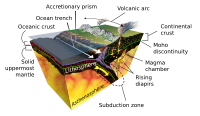
Photo from wikipedia
In order to assess the effects of critical zone processes on Mg concentrations and isotopic signatures of tropical streams, we studied a well constrained, highly weathered andesitic volcaniclastic catchment in… Click to show full abstract
In order to assess the effects of critical zone processes on Mg concentrations and isotopic signatures of tropical streams, we studied a well constrained, highly weathered andesitic volcaniclastic catchment in the Luquillo Critical Zone Observatory, Puerto Rico. Our results indicate that dissolved Mg concentrations and isotope ratios in the regolith pore water are mainly controlled by rain input, with weathering inputs being more important at sites with thinner regolith (2.7–0.9 m deep) and at depth (>8 m) on a thick ridgetop regolith (∼10 m). In addition to mixing of precipitation and weathering-sourced Mg, an isotopic fractionation process is taking place between dissolved Mg and the regolith, likely during dissolution or recrystallisation of Fe(III)-(hydro)oxides under alternating redox conditions. Bulk regolith is isotopically heavier than both the bedrock and the exchangeable fraction (δ26Mgregolith-bedrock = +0.03 to +0.47‰), consistent with the preferential incorporation of heavy 26Mg into secondary minerals with some exchange of sorbed Mg with isotopically lighter pore water. Magnesium concentrations in the stream show a typical dilution behaviour during a storm event, but the [Mg] – δ26Mg pattern cannot be explained by mixing of rain and pore water; the data are best explained by a steady-state fractionation model with α = 1.00115. During baseflow the stream has δ26Mg = +0.01‰, higher than any of the water samples or the bedrock. In-situ analysis of the Mg isotopic composition of bedrock minerals points at the dissolution of Mg-rich chlorite (δ26Mg = +0.19‰) as the most likely source of this isotopically heavy Mg, with mass balance calculations indicating chlorite dissolution is also the main source of Mg to the stream. Overall, our study highlights the importance of atmospheric input of nutrients to the vegetation in tropical areas covered by thick, highly leached regolith, whereas the Mg flux and Mg isotopic signature of watershed exports are dominated by bedrock dissolution delivered to the stream through deeper, usually un-sampled critical zone pathways.
Journal Title: Geochimica et Cosmochimica Acta
Year Published: 2017
Link to full text (if available)
Share on Social Media: Sign Up to like & get
recommendations!